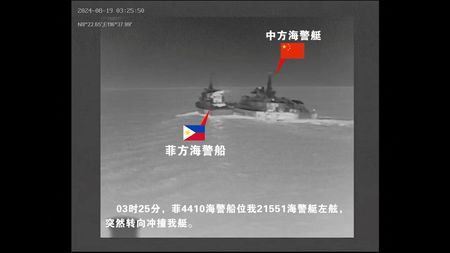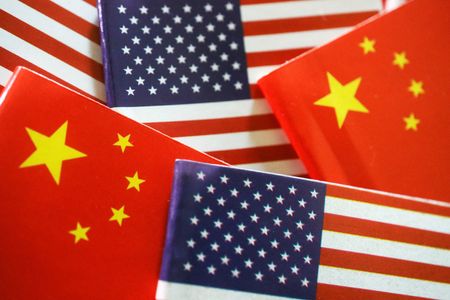BEIJING/MANILA (Reuters) -The Philippines and China accused each other on Monday of ramming vessels and performing dangerous manoeuvres in the South China Sea, the latest flare-up after the two nations agreed last month to try to manage disagreements at sea.
China’s Coast Guard said in a statement a Philippine vessel which had ignored its repeated warnings had “deliberately collided” with a Chinese vessel in an “unprofessional and dangerous” manner in the disputed waterway early on Monday.
The Philippines disputed Beijing’s account and accused it of “imposing its version of facts.” It said two of its coast guard vessels “encountered unlawful and aggressive manoeuvres” from Chinese vessels near Sabina Shoal, while on their way to supply Filipino personnel stationed in two occupied islands.
“These dangerous manoeuvres resulted in collisions, causing structural damage to both PCG (Philippine Coast Guard) vessels,” said Jonathan Malaya, a spokesperson for the national security council and Manila’s South China Sea task force.
At a regular news briefing, Chinese foreign ministry spokesperson Mao Ning told reporters that China would continue to take lawful “resolute and forceful measures” to safeguard its territorial sovereignty and maritime rights and interests.
“We hope that the Philippines can keep its commitments (and)earnestly abide by the temporary arrangements reached with China,” Mao said.
The United States condemned China’s actions. Its ambassador to Manila, MaryKay Carlson, said on X the U.S. “stands with the Philippines in condemning the China Coast Guard’s dangerous manoeuvres”, which endangered lives and caused damage to coast guard vessels.
Manila said coast guard vessels Cape Engano and Bagacay were on their way to resupply personnel stationed on Flat Island – which Manila calls Patag – and Lawak Island, which China calls Nanshan, when the confrontation happened near Sabina Shoal.
STRUCTURAL DAMAGE
The collision occurred between the Cape Engano and a Chinese ship at around 3:24 a.m.
Monday (1924 GMT Sunday), Manila said.
Around 16 minutes later, a Chinese coast guard ship rammed Manila’s Bagacay twice, damaging its auxiliary room, where a 3-foot (1 metre) – wide hole was inflicted, according to Philippine officials and images shared by the PCG.
“This is the biggest structural damage that we have incurred as a result of the dangerous manoeuvres carried out by the Chinese Coast Guard,” PCG Spokesperson Jay Tarriela said.
The Chinese Coast Guard posted a short video of the incident which showed what it said was a Philippine coast guard ship “deliberately ramming” with what it said was one of their vessels.
Malaya said the video was misleading.
China’s maritime security said the same Philippine vessel involved in the collision then entered waters near Second Thomas Shoal after being prevented from entering Sabina Shoal waters.
Sabina Shoal is in the Spratly Islands, which are claimed by China, the Philippines, Taiwan and Vietnam.
Two Philippine Coast Guard vessels “illegally intruded” into waters adjacent to Sabina Shoal without permission in the early hours of Monday, according to China Coast Guard spokesperson Gan Yu.
China’s Coast Guard said it took control measures against the Philippine ships in accordance with the law and warned the Philippines to “immediately stop infringement and provocation”.
The Philippine task force said both of its vessels would continue with their mission to supply personnel on Flat Island.
The incident came less than two weeks after an air incident between the Chinese and Philippines militaries in Scarborough Shoal.
(Reporting by Liz Lee in Beijing and Shanghai newsroom and Karen Lema in Manila; Additional reporting by Eduardo Baptista in Beijing; Editing by Michael Perry and David Holmes)












